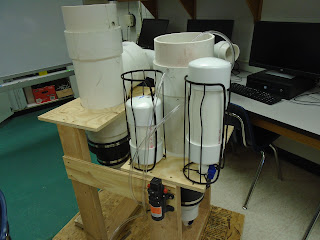Work Installing Condenser, Fan Mount and Tubing
Date: 4.28.18
Location: Logan HS
Time: 5 hours
Goal: Install the condenser module, run wires and tubing and work on fan mount.
Students: Austin, Paige, Alex and Caitlin
The condenser installation was not easy! It needed to be manipulated in such a way as to allow the tubing and wires to be oriented toward the pumps, reservoirs and electrical panel. Care had to be taken with the micro vibration motors so as not to disconnect one. It was almost 2 hours to get this unit fitted with all the holes drilled and the orientation correct.
Once that was in, running the tubing to the peltiers went smoothly. We still have to finish that work.
Portholes were cut in and seemed to allow adequate visionary access to the tanks. Electrical diagrams were drafted and work started on the mount for the fan motor. The fan motor mount is proving to be a challenge due to where it has to be located (on the elbow of a PVC pipe).
We feel we are close to a pump test this week which would be a "milestone event" as we need to check for leaks and water flow. We also are ready to start work on the wireless transmitter to capture a video image of the controls. We are going to try a Rasberry Pi3 for this application.
A future goal is to run all the wires into switches and fuse box.
 |
| Austin applying silicone on the micro vibration motors. to seal them up from water. |
 |
| Condenser tank off the cart and holes marked out for drilling. |
 |
| Porthole being drilled in with a plastic furniture leg carpet protector as our "porthole". |
 |
| We used a dremel tool to cut in the hole and then siliconed the porthole in. |
 |
| Condenser module with the wiring and tubing completed. If we posted a picture of this by itself on the Internet, we wonder how many people would guess what it is. |
 |
| Condenser module installed in the tank. This picture is looking up from the bottom. Notice how wires are zip tied to protect them. The bottom of the condenser unit is siliconed to the PVC tank to force air flow through the radiators. |
 |
| Top view of condenser module installed. |
 |
View showing porthole installed so students can see the water flow out of the condenser module.
A LED will be used to light up the tank. |
 |
| Electrical box installed in the lower front for us to run wires into. |
 |
| Draft of electrical schematic. |
 |
| Draft of additional electrical schematic. |
Video of the Condenser Module. Notice the two holes in the plexiglass on either end
of the radiator which are to allow a small amount of air flow to drop to the bottom
condenser unit. We hope both radiator will be utilized more efficiently that way.
 |
| Salt water tank inlet was drilled and tapped into the PVC tank. The hose will connect to the 3/8" barb. |
 |
| The fan motor bracket has to be square with the 4" pipe it is running into. This proved to be a challenge to machine. |
 |
| Aligning the main shaft for the fan and fan motor. |
 |
| Raw materials and 12 V DC fan motor for mount. |
 |
| Cutting out the fan mount. The two flanges will be bent to the circumference of the 4" elbow. |
 |
Completed fan mount bracket with holes drilled for motor. We created a paper template to transfer
the pilot holes to the aluminum plate. |
 |
| On the evaporator side, we cut in holes to hang the eventual shower head. |

























































